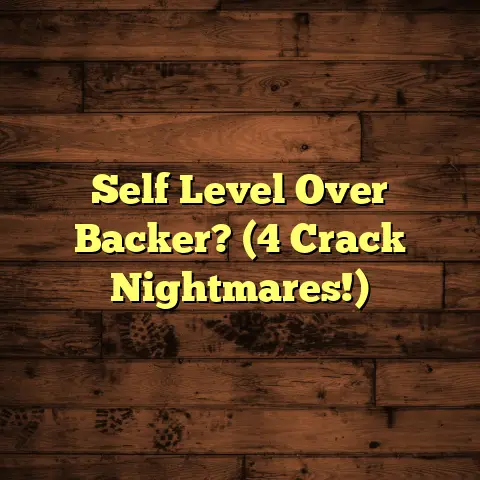Urine Stains on Hardwood? (2-Step Fix!)
Discover the Timeless 2-Step Fix!
I’ve seen it all – from water damage to termite infestations.But one of the most common issues I get called about? You guessed it: pet urine stains on beautiful hardwood floors. It’s a problem that mixes aesthetics with hygiene, and trust me, I understand the frustration.
Hardwood flooring brings a timeless elegance to any home. But, accidents happen, especially if you have furry friends. Luckily, you can restore your floors to their former glory with a straightforward two-step process!
In this guide, I’ll walk you through everything you need to know about tackling those pesky urine stains. We’ll cover everything from why they happen to exactly how to fix them. Let’s dive in!
Section 1: Understanding Urine
Stains on Hardwood
So, what makes urine stains so tough to deal with? It’s all about the composition and how it interacts with the wood. Let’s break it down.
1.1 The Composition of Urine
and Its Effects on Wood
Urine isn’t just water. It’s a complex mixture of compounds like urea, uric acid, ammonia, creatinine, and various salts and minerals. These components are the culprits behind the staining and odor.
-
Urea: This is a nitrogen-containing compound that bacteria break down into ammonia, contributing to that pungent smell.
-
Uric Acid: This crystalizes and binds to surfaces, making it difficult to remove. Uric acid crystals are also a major source of lingering odor, even after cleaning.
-
Ammonia: A strong alkali, ammonia can react with wood finishes, causing discoloration and damage.
When urine soaks into hardwood, these compounds penetrate the wood fibers and react with the finish. The finish, which is designed to protect the wood, can be etched or dissolved by the ammonia and acids.
Over time, the wood itself can become discolored, leading to dark spots and permanent staining. Plus, if left untreated, the moisture can create a breeding ground for mold and bacteria, which can lead to health issues.
1.2 Identifying Urine Stains
Catching urine stains early is crucial. Here’s what to look for:
-
Visual Cues: Fresh stains often appear as wet or damp spots that are darker than the surrounding wood. Older stains may look like dark or yellowish spots.
-
Lingering Odors: Even if you can’t see a stain, a persistent ammonia-like odor is a telltale sign.
-
Distinguishing Fresh vs. Old: Fresh stains are easier to clean because the urine hasn’t fully penetrated the wood. Old stains, on the other hand, have had more time to set in and may require more aggressive treatment.
The sooner you spot the stain, the easier it will be to remove. Regular inspections, especially in areas where your pets spend most of their time, can help you catch accidents early.
Section 2: The Importance of
Prompt Action
Time is of the essence when dealing with urine stains. Here’s why:
2.1 Why Immediate Attention is Crucial
The longer urine sits on your hardwood, the worse the damage becomes.
-
Wood Integrity: Urine can weaken the wood fibers over time, leading to warping, cracking, and even rot. According to the Forest Products Laboratory, prolonged exposure to moisture can reduce the structural integrity of wood by up to 30%. (Source: USDA Forest Service).
-
Embedded Odors: The longer the urine sits, the deeper the odors penetrate. Once the smell is embedded in the wood, it can be incredibly difficult to remove, requiring professional cleaning or even floor replacement.
-
Mold and Bacteria: Damp, untreated areas are perfect breeding grounds for mold and bacteria. This can lead to health issues and further damage to your flooring.
2.2 Tools and Materials You Will Need
Before you start cleaning, gather your supplies. Here’s what I recommend:
-
Essential Cleaning Supplies:
- White Vinegar: A natural disinfectant and odor neutralizer.
- Baking Soda: Excellent for absorbing odors and moisture.
- Enzyme Cleaners: Specifically designed to break down urine components. (I recommend Nature’s Miracle or Rocco & Roxie Stain & Odor Eliminator.
- Hydrogen Peroxide (3%): For stubborn stains, but use with caution on dark woods as it can lighten them.
-
Recommended Tools:
- Soft Cloths: Microfiber cloths are great for absorbing liquids.
- Mop: For larger areas.
- Bucket: For mixing cleaning solutions.
- Protective Gloves: To protect your hands from harsh chemicals and bacteria.
- Spray Bottle: For applying cleaning solutions.
- Old Toothbrush: For scrubbing stubborn stains.
- Plastic Wrap: To keep the area moist when using enzyme cleaners.
Section 3: Step One – Cleaning
the Stain
Alright, let’s get down to business. Here’s how to clean those urine stains effectively.
3.1 Preparing Your Workspace
Before you start, make sure you have a clean and organized workspace.
-
Clear the Area: Remove any furniture, rugs, or other items from the affected area. This will give you plenty of room to work and prevent any further staining.
-
Ensure Proper Ventilation: Open windows and doors to provide good airflow. This will help dissipate odors and prevent the buildup of fumes from cleaning products.
3.2 The Cleaning Process
Now, let’s get to the nitty-gritty of cleaning the stain.
-
Step-by-Step Guide to Blotting Fresh Stains:
- Act Fast: The quicker you act, the better.
- Blot, Don’t Rub: Use a clean, dry cloth to blot up as much urine as possible. Rubbing can spread the stain and damage the wood fibers.
- Apply Pressure: Apply firm pressure to absorb the urine. You may need to use several cloths to soak up all the liquid.
-
Using Natural Solutions: Vinegar and Baking Soda:
- Vinegar Solution: Mix equal parts white vinegar and water in a spray bottle.
- Spray the Area: Lightly spray the stained area with the vinegar solution. Don’t saturate the wood.
- Let it Sit: Allow the solution to sit for 5-10 minutes. The vinegar will help neutralize the urine and break down the stain.
- Blot Again: Use a clean cloth to blot up the vinegar solution.
- Apply Baking Soda: Sprinkle a generous amount of baking soda over the treated area. The baking soda will absorb any remaining moisture and odors.
- Let it Dry: Allow the baking soda to sit for several hours, or preferably overnight.
- Vacuum: Vacuum up the baking soda.
-
How to Apply Enzyme Cleaners Effectively:
- Follow Instructions: Read and follow the manufacturer’s instructions carefully.
- Apply Generously: Saturate the stained area with the enzyme cleaner. Make sure the cleaner penetrates deep into the wood fibers.
- Cover with Plastic Wrap: Cover the treated area with plastic wrap to keep it moist. This will help the enzymes work more effectively.
- Let it Sit: Allow the enzyme cleaner to sit for the recommended time, usually 24-48 hours.
- Remove Plastic Wrap: Remove the plastic wrap and let the area air dry completely.
-
Tips for Dealing with Old or Stubborn Stains:
-
Hydrogen Peroxide: For old stains, you may need to use a stronger solution. Mix 1/2 cup of 3% hydrogen peroxide with 1 tablespoon of ammonia. Apply the solution to the stain and let it sit for a few hours. Blot dry. Warning: This can lighten the wood, so test in an inconspicuous area first.
-
Repeat if Necessary: Sometimes, you may need to repeat the cleaning process several times to completely remove the stain and odor.
-
Section 4: Step Two – Neutralizing
Odors and Protecting Your Floor
Once you’ve cleaned the stain, it’s time to neutralize any lingering odors and protect your floor from future accidents.
4.1 Odor Neutralization Techniques
Even after cleaning, odors can linger. Here’s how to get rid of them:
-
The Role of Baking Soda in Absorbing Smells: Baking soda is a natural odor absorber. Sprinkle a generous amount over the affected area and let it sit for 24-48 hours before vacuuming.
-
Using Essential Oils for a Pleasant Scent: After cleaning, you can use essential oils to add a pleasant scent to your floor. Add a few drops of your favorite essential oil (like lavender or citrus) to a bucket of water and mop the floor.
-
Importance of Thorough Drying: Make sure the floor is completely dry after cleaning. Use fans or a dehumidifier to speed up the drying process.
4.2 Restoring and Protecting Your Hardwood
After cleaning and odor removal, it’s time to restore and protect your hardwood.
-
Evaluating the Finish: When to Reapply or Refinish: Check the finish on your floor. If it’s damaged or worn, you may need to reapply a coat of polyurethane or refinish the entire floor.
-
Recommended Products for Protection Against Future Stains: Consider using a hardwood floor protector or sealant to prevent future stains. Look for products that are specifically designed for hardwood floors and are safe for pets and children.
-
Preventative Measures to Keep Your Hardwood Pristine:
- Regular Cleaning: Sweep or vacuum your hardwood floors regularly to remove dirt and debris.
- Use Rugs and Mats: Place rugs and mats in high-traffic areas to protect the floor from scratches and stains.
- Trim Pet’s Nails: Keep your pet’s nails trimmed to prevent scratches.
- Clean Up Accidents Immediately: The faster you clean up accidents, the less likely they are to cause permanent damage.
Section 5: Long-Term Care for
Hardwood Floors
Maintaining your hardwood floors requires ongoing care. Here are some tips for long- term maintenance.
5.1 Establishing a Regular Cleaning Routine
A consistent cleaning routine is essential for keeping your hardwood floors in top condition.
-
Best Practices for Daily and Weekly Maintenance:
- Daily: Sweep or vacuum to remove dirt and debris.
- Weekly: Mop with a hardwood floor cleaner.
-
Products to Avoid That May Damage the Finish: Avoid using harsh chemicals, abrasive cleaners, or steam mops, as these can damage the finish on your hardwood floors.
5.2 Managing Pet Behavior
Training your pets can help prevent future accidents.
-
Training Tips to Reduce Accidents:
- Potty Training: Train your pets to eliminate outside.
- Designated Area: Create a designated area for your pets to relieve themselves.
- Positive Reinforcement: Reward your pets for eliminating in the correct area.
-
Creating a Designated Area for Pets: If your pets are prone to accidents, consider creating a designated area with a waterproof mat or litter box.
5.3 When to Call a Professional
Sometimes, the damage is too severe to handle on your own.
-
Signs That a Stain May Require Expert Intervention:
- Deep Stains: If the stain has penetrated deep into the wood fibers.
- Extensive Damage: If the floor is warped, cracked, or rotting.
- Persistent Odors: If you can’t eliminate the odor after multiple cleaning attempts.
-
How to Choose the Right Flooring Professional:
- Experience: Look for a professional with experience in hardwood floor cleaning and restoration.
- Reputation: Check online reviews and ask for references.
- Insurance: Make sure the professional is licensed and insured.
Conclusion:
Restoring your hardwood floors after a urine stain doesn’t have to be overwhelming. With this two-step fix, you can reclaim the beauty of your flooring and maintain a clean, inviting home.
Remember, prompt action, effective cleaning techniques, and regular maintenance are key to preserving the elegance of your hardwood surfaces for years to come. Your floors deserve the best care, and with the right approach, they will continue to shine!
So, tackle those stains head-on, and enjoy the timeless beauty of your hardwood floors. Good luck, and happy cleaning!





